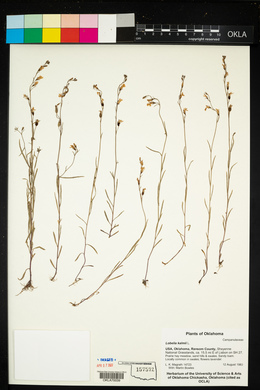Lobelia kalmii
|
|
|
|
Family: Campanulaceae
Brook Lobelia, more...Ontario lobelia
[Lobelia kalmii f. leucantha Rouleau, moreLobelia kalmii var. capillaris Farw., Lobelia kalmii var. edithae E. Wimm., Lobelia kalmii var. strictiflora Rydb., Lobelia strictiflora (Rydb.) Lunell] |
Perennial herb 10 - 60 cm tall Stem: single or branched, slender, normally stiffly erect, fairly hairless. If the stem is broken or cut, it exudes milky sap. Inflorescence: of loose, sometimes one-sided branches with stalked flowers singly in axils of very narrow, up to 1.5 cm long bracts. The flower stalks are rarely longer than the subtending bracts, and there are two tiny, nub-like bracts (bracteoles) located at or above the middle of each stalk. Flowers: purple-blue with white center, 0.7 - 1.5 cm long, bilaterally symmetric with small two-lobed upper lip and larger three-lobed lower lip. The flowers are actually flipped upside down so that the morphologic upper lip (of three spreading lobes) appears on the bottom of the flower, and the two rather erect shorter lobes at the top of the flower are actually the morphologic lower lip. Sepals: five, 2 - 3 mm long overall, but fused for about half their length into a short funnel-shaped tube, then separating into five, slender lobes, which lack ear-like appendages (auricles) between their bases. The fused tube portion of the sepals becomes inflated in fruit. Petals: five, but fused for about half their length into a tube, then separating into two lips with two small, sometimes divergent, fairly erect lobes above, and three longer, wider, spreading lobes below. Unlike some other species in the genus, the two-lobed "upper" lip (morphologic lower) has no beard of hairs near the base, but the "lower" lip (morphologic upper) has a distinct white patch just before the three spreading lobes separate from each other. Stamens: five, but fused into a tube with two anthers bearded at tip and shorter than the other three. Pistil: with a two-chambered, inferior ovary; one long style positioned through center of stamen tube; and a two-lobed, often fringed stigma. As the style elongates up through the stamen tube, it pushes the pollen out of the anthers. Fruit: several, two-chambered, elliptic to rounded, many-seeded capsules, each surrounded by united portions of sepals and petals, which become strongly inflated as fruit matures. Basal leaves: stalked, 1 - 3 cm long, spoon-shaped, hairy and often dying back before flowering. The basal leaves are sometimes located underwater. Stem leaves: alternate, stalkless, linear to lance-shaped, 1 - 5 cm long, and normally less than 3 mm wide. Similar species: Lobelia kalmii can be confused with small, or unusually small-leaved individuals of L. inflata and L. spicata except both those species have the flower stalk bracteoles located near the base rather than above or near the middle of the stalk. In addition to the location of the small bracteoles, L. inflata has long hairs covering at least the base of the stems where as the stems of L. kalmii are normally hairless. Lobelia spicata can further be distinguished by its finely-hairy, wider, and more elliptic leaves, as well as the longer sepal lobes that are at least two times the length of the fused sepal tube. Flowering: July to early November Habitat and ecology: Not particularly common, predominantly found in calcareous springy areas and dune flats, particularly around the pannes near Lake Michigan. Occurence in the Chicago region: native Notes: This species of Lobelia has a milky latex sap. Many species in the genus have leaves that are acrid and contain poisonous substances, but some drugs and medicines are extracted from them (Voight and Mohlenbrock 1985). Author: The Field Museum Glabrous or subglabrous perennial 1-4 dm; basal lvs spatulate, 1-3 cm, sometimes immersed, often deciduous; cauline lvs mostly linear, 1-5 cm נ1-5 mm; racemes loose, sometimes secund; bracts linear or filiform, the lower to 15 mm; pedicels bibracteolate at or above the middle; sep 2-3 mm; cor 7-13 mm, blue to partly or wholly white, the lower lip glabrous; 2n=14. Calcareous shores and swamps; Nf. to B.C., s. to Pa., O., Ill., and Minn. July, Aug. (L. strictiflora) Gleason, Henry A. & Cronquist, Arthur J. 1991. Manual of vascular plants of northeastern United States and adjacent Canada. lxxv + 910 pp. ©The New York Botanical Garden. All rights reserved. Used by permission. From Flora of Indiana (1940) by Charles C. Deam Locally frequent to common in calcareous habitats such as wet, manly borders of lakes and in marshes. It is usually associated with Parnassia glauca. .…… Indiana Coefficient of Conservatism: C = 10 Wetland Indicator Status: OBL |
|
|
|












































































